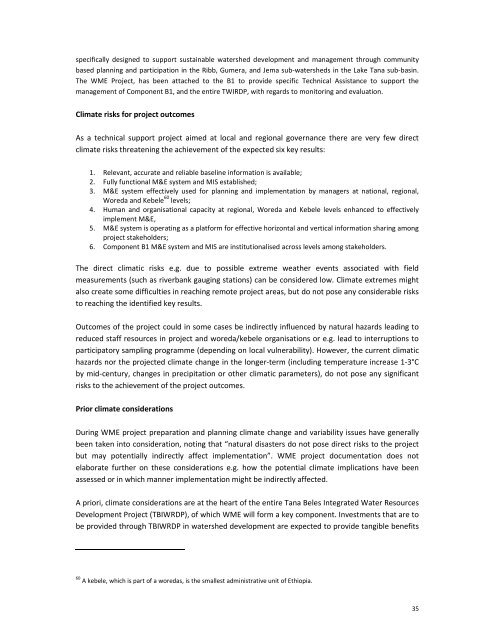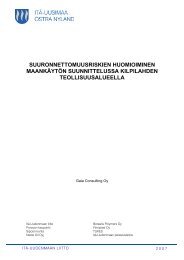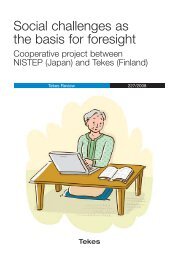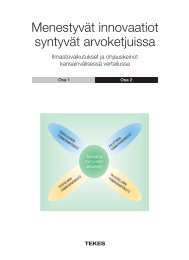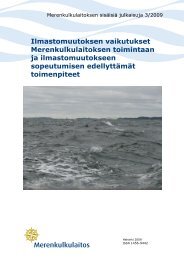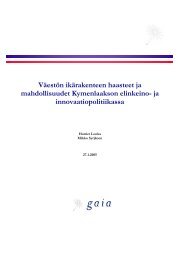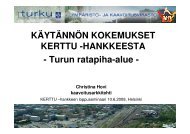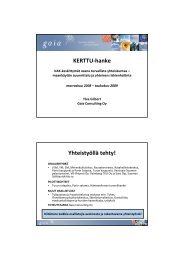Climate Risk Management in Finnish Development Cooperation - Gaia
Climate Risk Management in Finnish Development Cooperation - Gaia
Climate Risk Management in Finnish Development Cooperation - Gaia
You also want an ePaper? Increase the reach of your titles
YUMPU automatically turns print PDFs into web optimized ePapers that Google loves.
specifically designed to support susta<strong>in</strong>able watershed development and management through community<br />
based plann<strong>in</strong>g and participation <strong>in</strong> the Ribb, Gumera, and Jema sub-watersheds <strong>in</strong> the Lake Tana sub-bas<strong>in</strong>.<br />
The WME Project, has been attached to the B1 to provide specific Technical Assistance to support the<br />
management of Component B1, and the entire TWIRDP, with regards to monitor<strong>in</strong>g and evaluation.<br />
<strong>Climate</strong> risks for project outcomes<br />
As a technical support project aimed at local and regional governance there are very few direct<br />
climate risks threaten<strong>in</strong>g the achievement of the expected six key results:<br />
1. Relevant, accurate and reliable basel<strong>in</strong>e <strong>in</strong>formation is available;<br />
2. Fully functional M&E system and MIS established;<br />
3. M&E system effectively used for plann<strong>in</strong>g and implementation by managers at national, regional,<br />
Woreda and Kebele 60 levels;<br />
4. Human and organisational capacity at regional, Woreda and Kebele levels enhanced to effectively<br />
implement M&E,<br />
5. M&E system is operat<strong>in</strong>g as a platform for effective horizontal and vertical <strong>in</strong>formation shar<strong>in</strong>g among<br />
project stakeholders;<br />
6. Component B1 M&E system and MIS are <strong>in</strong>stitutionalised across levels among stakeholders.<br />
The direct climatic risks e.g. due to possible extreme weather events associated with field<br />
measurements (such as riverbank gaug<strong>in</strong>g stations) can be considered low. <strong>Climate</strong> extremes might<br />
also create some difficulties <strong>in</strong> reach<strong>in</strong>g remote project areas, but do not pose any considerable risks<br />
to reach<strong>in</strong>g the identified key results.<br />
Outcomes of the project could <strong>in</strong> some cases be <strong>in</strong>directly <strong>in</strong>fluenced by natural hazards lead<strong>in</strong>g to<br />
reduced staff resources <strong>in</strong> project and woreda/kebele organisations or e.g. lead to <strong>in</strong>terruptions to<br />
participatory sampl<strong>in</strong>g programme (depend<strong>in</strong>g on local vulnerability). However, the current climatic<br />
hazards nor the projected climate change <strong>in</strong> the longer-term (<strong>in</strong>clud<strong>in</strong>g temperature <strong>in</strong>crease 1-3°C<br />
by mid-century, changes <strong>in</strong> precipitation or other climatic parameters), do not pose any significant<br />
risks to the achievement of the project outcomes.<br />
Prior climate considerations<br />
Dur<strong>in</strong>g WME project preparation and plann<strong>in</strong>g climate change and variability issues have generally<br />
been taken <strong>in</strong>to consideration, not<strong>in</strong>g that “natural disasters do not pose direct risks to the project<br />
but may potentially <strong>in</strong>directly affect implementation”. WME project documentation does not<br />
elaborate further on these considerations e.g. how the potential climate implications have been<br />
assessed or <strong>in</strong> which manner implementation might be <strong>in</strong>directly affected.<br />
A priori, climate considerations are at the heart of the entire Tana Beles Integrated Water Resources<br />
<strong>Development</strong> Project (TBIWRDP), of which WME will form a key component. Investments that are to<br />
be provided through TBIWRDP <strong>in</strong> watershed development are expected to provide tangible benefits<br />
60 A kebele, which is part of a woredas, is the smallest adm<strong>in</strong>istrative unit of Ethiopia.<br />
35


